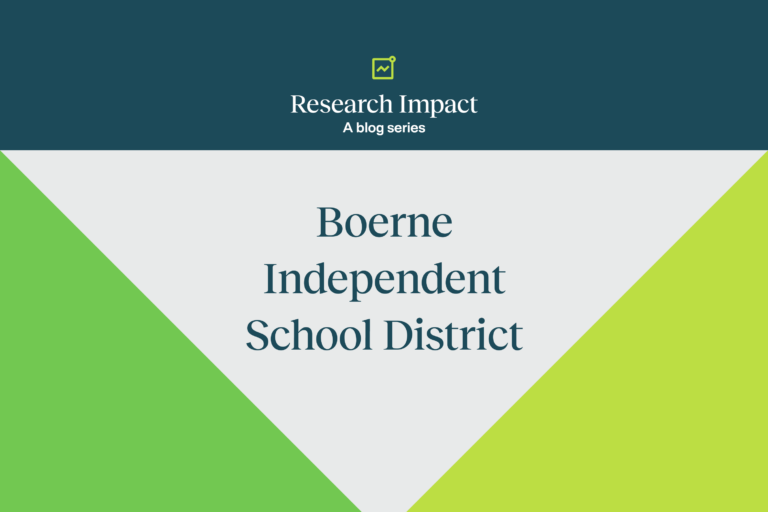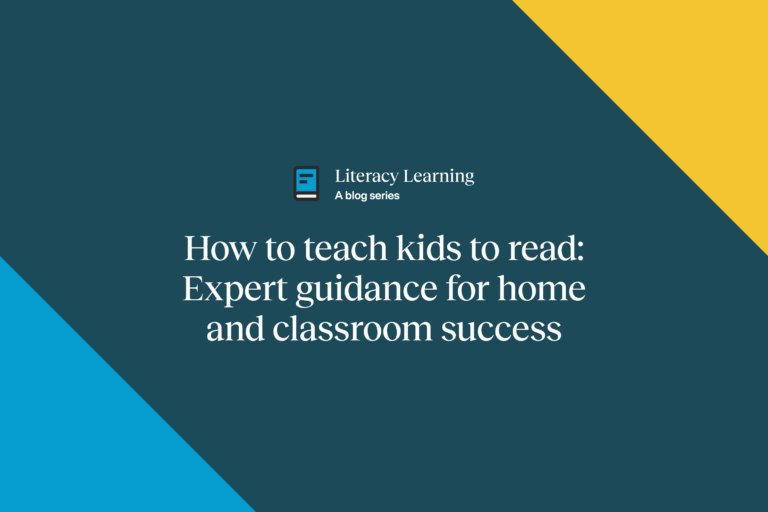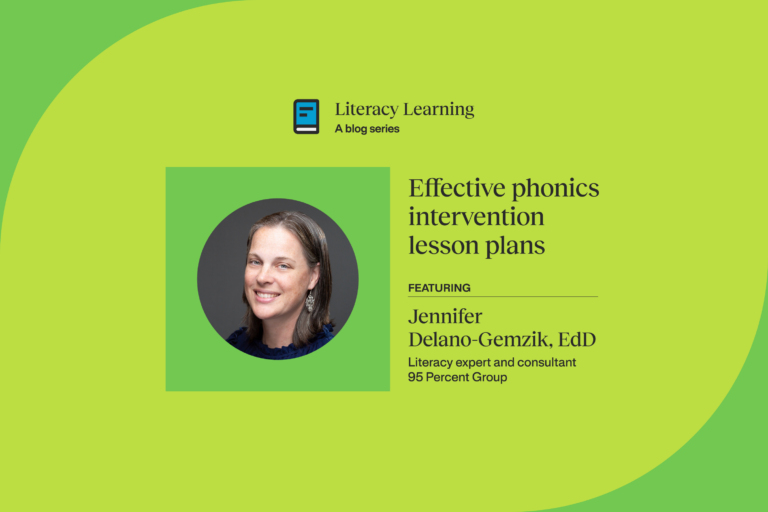Best practices for your Tier 2 literacy solution: Lessons learned from a California school district

In Part 2 of our interview with David Mack, EdD, Chief Administrator of Business Services, and Charley Clark, Assistant Superintendent of Fairfax School District, we explore best practices for professional learning in a successful Tier 2 implementation of structured literacy. Discover essential traits of dynamic literacy leaders.
Professional learning best practices
What have you learned through the successes and failures about training and professional learning best practices?
David Mack:
A big thing with any Tier 1 and Tier 2 implementation is ensuring that the school culture is understood and the ongoing training is sensitive to that culture. High-quality training needs to deliver what is promised because no one likes to waste their time.
Anytime you’re talking about implementation or starting something new, the teachers’ first impression will be that initial training. So, getting that first impression of the program to make sure that it’s a positive experience is so important. In our experience, it has to be in person. We had a less-than-optimal experience with online training on Zoom during COVID. You don’t get that engagement. You don’t get that understanding, right?
Professional learning has to be engaging. You have to have the experts in the room because teachers are smart, and they’re going to ask hard questions, and you need to be able to answer those questions confidently. When teachers with resistance ask questions, you have someone who can positively assertively give that response in the right way at the right time. That immediate feedback is so key.
Of course, literacy coaches have to actually deliver on their promises. For example, if they say they will show how to deliver the program in 30 to 45 minutes, they need to deliver on that promise. If or when they don’t, they can return all the progress made. Trust is key.
Walking the walk for literacy
Charley Clark:
I’ll also add: the second most important part to having a dynamic trainer with sensitivity to the culture is to have a leader who is learning side-by-side.
So, when I talked about how I wanted that steamrolling mentality to happen with Dibels, part of my approach was I tested with our reading lab. So they always had a table for me—I would go in there, and the teachers would bring their classes in. We told teachers, “You can just sit in the back and watch. You don’t have to test. We’ll test them.” But when they saw me come in and test, they were encouraged and confident they could.
When bringing in 95 Phonics Core Program®, Dr. Mack did the same thing. I remember going through a session with Kim Dale, our superstar literacy coach, and she wanted to talk to one of the aides or a teacher in the training. Dr. Mack jumped in, sat at the table, and completed the lesson because he knew how to do it. That gets so much buy-in with your staff if you have a leader who walks the walk. It’s easy to say we need you to do this program, but when they see us doing it with them, they’re much more inclined to jump on board.
Could you share some Aha! moments you experienced with the Tier 2 implementation?
Charley Clark:
Oh, definitely. I was only a principal at the site for four years before I came over to the district office. And at the beginning of my fifth year, I returned to the school. I was talking to a group of third grade teachers—this was before COVID. These kids have had 95 Percent Group for four years—Kindergarten, first, second, and third. They said this is the first year they’ve ever had a class that can read. They come in and they are reading. So, this was in 2019. That was probably our highest achieving year—our CAASPP scores were starting to soar because those kids in the early phases were getting into those testing grades.
Our whole philosophy as a school was: We’re going to teach them how to read in K-3 so we can teach them the content in 4-6. We stopped worrying about things like adverbs in first grade because who cares what an adverb is if you can’t read?
We took many curriculum-type things and asked what was non-negotiable and what was not. Many negotiable things exist if your kids aren’t reading because reading is the number one priority. Seeing it sustained over a few years, we saw some killer results. We had a reset from COVID for fill-in-the-blank reasons—kids are different after COVID. And we’re starting over, but now, with Tier 1 being done to fidelity, we’re beginning to trend back up in the right direction.
This morning, Dr. Mack and I reviewed our Acadience data for the last three years of quarter two. We’re seeing our kids return to where they should be. And I attribute that 100% to 95 Percent Group from Tier 1 and Tier 2. I mean, it’s without a doubt.
Shared passion and mindset for structured literacy
What kind of impact has your work at your school had on other schools in the district? Being named a Title 1 Model School must have been influential. How is that playing out?
David Mack:
Well, I have to say, when you wanted to have a conversation about Tier 2, I knew we could not have this conversation without bringing in Charley because we would not have had success at any of our schools If it wasn’t for Charley at the beginning. We were very fortunate. Charley, one of our other district administrators who was in charge of special education today, and I were all principals at the time. It was a heyday because the three of us all had the same mindset of how we wanted to see reading programs go and we all had this passion for working alongside our teachers and our staff and getting in the weeds. It was a lot of fun to be a principal at that time.
Have other schools been inspired by what you’re doing?
Charley Clark:
We’re a pretty small school district. There are only three elementary schools and one junior high. But the data speaks for itself. And so when we would look at district data and the scores at my school were skyrocketing, and the other two were pretty flat, it didn’t take much convincing for other people to ask, “Hey, what are you doing?”
And so, the other school jumped on board quickly.
Branding our programs
One great thing we did was we branded the effort by our sites. We called our team “Our time, Win time, What I need.” Dr. Mack called it AMP, which stood for “at my pace.” One of our other schools now calls it POP—Pursuit of Progress.
We branded it and made it a part of what we do. It’s not like it was before we started when the approach was, “Oh, go to your intervention room. You three kids go over.” There wasn’t any kind of stigma. It was, “Oh, we all walk to a different classroom.”
When they heard about the successes, Dr. Mack brought over some key people who needed to see it. Good leaders can always identify your movers and shakers, and if you get them on board, that’s more than half the battle. He brought over a very key player, and I had all my key players in the room. Then we both sat back and listened. The conversation, when it’s teacher-driven, spreads like wildfire. No one cares what an administrator tells you. When they hear it from another teacher, someone they respect, then it’s much more well-received.
Building a data culture for reading intervention
What obstacles led you to begin with Kindergarten in bringing in Tier 2?
Charley Clark:
On the outside, it looks like, “Oh, it makes sense to start in Kindergarten.” But I had the most supportive team in Kindergarten. So that’s what made me choose Kindergarten. And they respected our reading specialist at the time so much that we could have done anything. And so we said, “Okay, we’re going to start with you guys.”
Then, we started this culture of having data teams regularly. We had to teach them that you don’t need to keep your data to yourself. We’re at a point now where we can go into a grade level, share scores from classes with each other, and have a true discussion about the data. So, there was a lot of work on making people feel comfortable. But once we started shifting our mindset to “They’re our kids and not my kids,” they were more willing to talk about data. You get the class that you’re dealt. You can’t control how they come in. You certainly can control some things that impact their growth. Once we overcame that hurdle, they were more willing to discuss data. And then it was like, “Okay, we’ve identified that they’re low. Now what?”
And that’s where 95 Percent Group has come in. Susan Hall’s book is called I’ve Dibeled, Now what? This is the “now what.”
Needed: dynamic literacy leaders
Would you like to share any other lessons learned or best practices?
David Mack:
I will say that for modern schools to be successful, the old adage that principals or site administrators are just managers has to change. If you want a successful school, you need a dynamic instructional leader. And these leaders need to be experts in the field. You need to be a math expert. You need to be an ELA expert.
You have to stay abreast of the changes, right? If you’re anything worth your salt, you understand the science of reading and that there’s a lot of tension in approaches to reading instruction. You understand the different controversies so that you can manage them. Your staff gets so influenced by TikTok and Instagram feeds now, and they don’t always get all the facts from those social media feeds.
You need to be a data scientist and know how to interpret real data in real-time. You have to make sure that you motivate your teachers to make those data-informed decisions and that the data you’re collecting is clean and meaningful.
Charley and I were just looking at something on attendance today. It’s about us going through and cleaning up bad data because we had some bad data in there that would have made us make some difficult choices that wouldn’t have been correct based upon the data. You have to make sure that all your details are entered in correctly.
You need to be a jack of all trades, right? You may not be a master of all, but a master of some is better than none, right? So you need to have all those things down pat and be involved, engaged, and excited about what you’re implementing. You need to have a passion behind it.
Getting in the weeds
Charley Clark:
I agree a hundred percent with Dave. We have very similar philosophies on site leadership and leadership in general about how you have to walk the walk. It’s really easy for teachers to dismiss administrators with, “Oh well, you’re just an administrator, you’re not in the classroom, you don’t know.”
David and I can talk about nonsense word fluency and reading rates and retell quality. We know what a CVC word is, we know how to finger stretch, we know what all the different colored chips are. We can talk about all those things.
When you have a principal who is leading data talks, when you can get in the weeds and have those kinds of conversations, people listen, and then they’re so much more inclined to follow. I think you see a lot of programs fall flat at school sites because principals or district leaders would say, “Okay, we’re using 95 Percent Group’s literacy ecosystem. Your trainers come in the day before school starts. Go do it.” Nothing is going to work if you’re not consistently in the room. I think the reason why 95 Percent Group has been so successful is because Dave and I have been so passionate about the program and because we’re so passionate about early literacy in general.
You need to have a mindset of leading by doing and leading by having high expectations. Dave’s rule was, “We are not going to cancel. I don’t care what’s going on. We are not canceling our reading lab for anything.” At another school site, one of the challenges was they had some community-type events come up, and then it seemed like some of the program would stop for a couple of weeks or a month at a time. And then you have to get everybody back into it.
The biggest takeaway as a leader from this whole program is: How is it rolled out? Is it organized? Our schedules were really dialed in, and very organized. We thought of everything that could go wrong and how to plan for it. For example, what happens if two of your aides call in sick that day? What do you do with groups? You don’t cancel and this is how we’re going to shift. We got in the weeds and figured out all of those kinds.
Funding? It’s all about having clear priorities
Money can be a huge concern when trying to help a district make change. What advice do you have for schools with budgeting concerns?
Charley Clark:
It’s all about your district priorities. So, there was a district that I’m still close with—I almost went back to work for them recently, but their focus is not on reading. They spend their dollars on another important area. It’s all about what your district priorities are. And if you look at what your students need and it is their behavior, maybe you put all your eggs in that PBIS basket.
Funding is there. Dr. Mack loves to say “We can do everything. We just can’t do it all.” And so it really depends on what your priorities are. And then, if it’s important to you, you’ll find the money for it. You may have to cut something else, but you take care of your priority.
David Mack:
I will say this, this entire backbone of our program, our aides, are multi-funded. We use both federal and state funds to fund our instructional aides. All of our schools are Title One funds, so we receive extra federal dollars to support students with need, which the majority of students in our school district are, and we also have centralized goals in our LCAPs—that’s a specifically California term, which stands for Local Control and Accountability plan, where we set aside supplemental concentration dollars.
We’ve set specific goals. We take federal dollars, and we mix them with state dollars, right? We do have to do some special accounting and submit that to auditors. In my opinion, a lot of school districts are leaving money on the table because they aren’t willing to have staff fill out the daily accounting time cards that have to be submitted for federal reporting. They need to do some extra work and set up a system. Title One funds aren’t enough to do this program. So if we marry with another fund, we have the resources to do that. But with that, there’s some red tape that’s necessary to deal with. We do that. Absolutely.
I see a lot of people who are always cutting or scratching to find that extra dime. I’m going to step over a dime to find a dollar. I’m not going to sit there and see what I can cut when there’s plenty of times I can go find dollars out there. It’s much easier to affect your revenue than try and make a cut.
But no doubt, the smaller your school district, the more challenges you will have to engage because we have the same amount of paperwork that we have to submit as Los Angeles Unified, right? But they have a whole team of people to do it. You know, they’ll have a team of 20 people for their LCAP. We have a team of 3 for ours, right? We’ve figured out how to make it work because our priorities are clear.
About 95 Percent Group
95 Percent Group is an education company whose mission is to build on science to empower teachers—supplying the knowledge, resources and support they need—to develop strong readers. Using an approach that is based in structured literacy, the company’s One95™ Literacy Ecosystem™ integrates professional learning and evidence-based literacy products into one cohesive system that supports consistent instructional routines across tiers and is proven and trusted to help students close skill gaps and read fluently. 95 Percent Group is also committed to advancing research, best practices, and thought leadership on the science of reading more broadly.
For additional information on 95 Percent Group, visit: https://www.95percentgroup.com.



